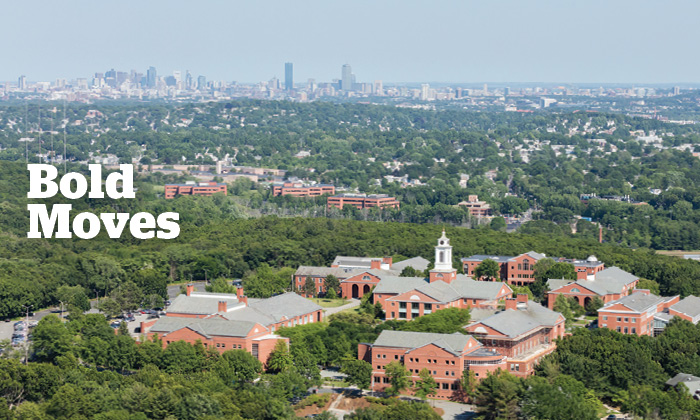
The story of Bentley’s campus begins in a single room that housed a whist club. We all know of the school’s decades on Boylston street in Boston before moving to Waltham. But the story has an even more improbable start in this obscure card room in the Chambers Huntington building located on Huntington Avenue.
When Harry Bentley decided to start his own school, his search for a suitable classroom ranged across the Back Bay and Fenway sections of the city. It eventually led to 30 Huntington Avenue, a space that was home to the Howell Women’s Whist Club. The club agreed to lease the room to Mr. Bentley several evenings a week and on Saturdays. Thus was launched a campus.
Of the many benchmarks that chart Bentley’s growth over 100 years — numbers of students, faculty, alumni, academic programs, extracurricular offerings — the story of the campus may be the most fascinating.
EDUCATION WITHOUT PRETENSE
Though offered in modest quarters, Mr. Bentley’s instruction quickly proved popular and his basic marketing methods — a catalogue, newspaper ads, word of mouth — were highly effective. Within a couple of years, enrollment reached 2,100. The growth spurred moves across the Back Bay, from Huntington Avenue to sites on Tremont Street, before reaching Boylston Street. He leased floors at what was 915 Boylston Street (later renumbered 921) for what had become the Bentley School of Accounting and Finance.
This four-story structure, once an automobile dealership and today owned by the Berklee College of Music, was an unpretentious but effective home for a school that offered an unpretentious but effective education.
This four-story structure, once an automobile dealership and today owned by the Berklee College of Music, was an unpretentious but effective home for a school that offered an unpretentious but effective education. In 1922, Bentley spent nearly $44,000 to renovate and improve the facility; still, it housed little more than classrooms, offices and a few lounges. The rectangular classrooms were fitted with desks, lecterns for instructors, blackboards and electric lights.
As touted in the school’s promotional literature: “Probably you are now impressed with the spaciousness of the rooms, the lighting effects, and the careful systematic planning which is common to all.” There was a “reception hall,” unusual in being luxuriously appointed in oak with expensive furniture.
It too was featured in advertising of the day, to entice young men to enroll. To read between the lines: A Bentley education could lead to this kind of opulence in your own life.
SIGHTS AND SOUNDS OF THE CITY
Every floor of the school had one or more smoking lounges. In the 1920s and many later decades, smokers included practically everyone — students, faculty, staff and 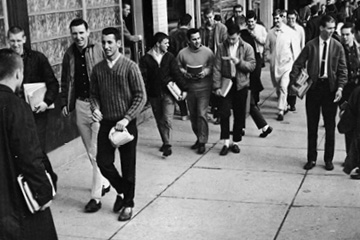 Harry Bentley himself. A planning analysis from 1952 noted that most classrooms and offices did not have windows, and that “the best lighted areas have been set aside for ‘Smoking Lounges.’ These lounges have no doubt been located in order to insulate the classrooms from the noises of traffic on Boylston Street and the nearby rail yards.”
Harry Bentley himself. A planning analysis from 1952 noted that most classrooms and offices did not have windows, and that “the best lighted areas have been set aside for ‘Smoking Lounges.’ These lounges have no doubt been located in order to insulate the classrooms from the noises of traffic on Boylston Street and the nearby rail yards.”
The sounds and sights of Boston punctuated life for Bentley students of the time. There was no library, no dining hall, virtually no facilities at all to support what is today called student life. The single exception was the Placement Department, which helped students and alumni find employment.
ADDING AMENITIES
In 1948, Mr. Bentley purchased 921 Boylston Street for $300,000 and began renting other nearby space for classes. The new decade brought steady improvements to enrich life outside the classroom. Additions included a library, a cafeteria, an infirmary, and guidance and counseling offices.
The school also made small steps toward becoming residential. Thus far, as a “streetcar school,” Bentley had turned its city location near public transit into a competitive advantage. Adding a residential component was a logical move as the school attracted more students from outside the Boston area, and even outside New England. The first dorms were rented facilities around the Back Bay. In 1960, the purchase of 373 Commonwealth Avenue, for $167,000, created Bentley’s first permanent residence hall.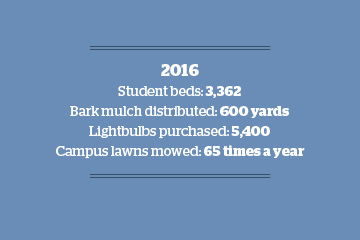
Enrollment growth during the 1950s strained facilities. As one faculty member observed: “There was no place for faculty or students to lounge about in the ‘old’ Bentley. Faculty offices were crammed; there were no spare classrooms standing empty. The alleyway behind the buildings, between Boylston Street and Newbury Street, was used by cars seeking parking places. Stairwells provided seating to those waiting for classes to empty so new groups could enter, and the broad sidewalks on Boylston filled every day.”
Talk of expansion grew. Leaders soon ruled out remaining in the city, given the cost and inability to have exactly the facilities they needed. And while many Bentley students preferred a city school, many more desired a traditional collegiate experience. In 1962,trustees authorized President Thomas Morison to move the college to a suitable suburban locale.
LOOKING WEST
Bentley considered sites in Belmont, Lexington, Needham and Dedham before settling on the Lyman Estate in Waltham. The purchase price was $365,000 for approximately 103 acres. A 1966 article in The New York Times announced the impending move, describing the site as a “100-acre knoll … that overlooks the industrial fringes of this suburban city” and noting that the nearby neighborhood features “a new development of ranch homes in the $40,000-and-up range.”
The purchase price was $365,000 for approximately 103 acres.
Many in the Bentley community, including some trustees, balked at the change. As Gregory H. Adamian, then a faculty member, observed many years later: “Surely there were those at the time who said the move would fail, and that it was better to stay in Boston and try to stick it out than to assume the incredible risk of moving an entire college. Tom [Morison], Rae [Anderson] and the institutional leadership of the day were not discouraged. They saw the risk, recognized the challenge and took it.”
‘TWELVE SHALL RISE’
The campus master plan called for 12 buildings (a handful, including today’s Lewis Hall, were already on the site). A fundraising publication of the time was titled Twelve Shall Rise Together. These were the library, the Faculty and Administration Building (today’s Morison Hall); the Classroom Building (Jennison Hall); Lindsay Hall; the Student Center (LaCava Center) and seven dorms (the Trees). The cost was approximately $15 million, which came largely from government loans and grants, operating funds, the sale of the various Boston properties and some support from alumni.
The campus was carefully designed to be both highly functional and attractive, and to make a statement about the institution. The style chosen was Georgian Colonial. As described by Dean Rae Anderson, who played a pivotal role in the move: “The buildings, featuring fine, solid New England brick relieved by white trim and embellished by graceful arches, stand in full harmony with the regional heritage of the college.”
This traditional design, with a few variations, has remained the basic look of the campus.
FORM AND FUNCTION
The new campus was dedicated in 1968. In a special supplement to The Boston Globe, published that November, President Morison spoke of Bentley taking “a giant, bold stride toward meeting today’s demands on American higher education.”
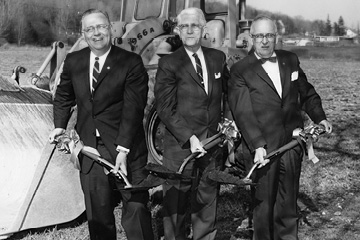 Thus began two decades of almost continuous construction, expansion and grounds improvements. From 1970 to about 1990, Bentley opened 17 new buildings and made several additions to existing facilities, totaling more than $70 million. Residence halls accounted for much of the expansion, as Bentley progressed steadily from weekend commuter college to a fully residential community. By the mid-1980s, for the first time ever, more students lived on campus than commuted — changing the culture of the institution in step with its physical development.
Thus began two decades of almost continuous construction, expansion and grounds improvements. From 1970 to about 1990, Bentley opened 17 new buildings and made several additions to existing facilities, totaling more than $70 million. Residence halls accounted for much of the expansion, as Bentley progressed steadily from weekend commuter college to a fully residential community. By the mid-1980s, for the first time ever, more students lived on campus than commuted — changing the culture of the institution in step with its physical development.
Other construction projects of the day were the Rauch Administration Center, Adamian Graduate Center, Dana Athletic Center and natatorium, and various athletic fields. The athletic facilities, as well as some new residences, were located on the “lower campus” (now south campus), across busy Beaver Street. To make foot traffic easier and safer, the college added a pedestrian bridge, which quickly became a highly visible symbol of the school.
“Bentley now possesses a beautiful and highly functional physical facility that makes possible the fulfillment of our academic mission,” observed Greg Adamian, who led much of the development as presi - dent from 1970 to 1991.
ROOM TO GROW
The next major phase of campus development unfolded in the late 1990s, under Bentley’s sixth president, Joseph G. Morone. Two nearby properties had become available in quick succession. The DeVincent Farm land, contiguous to the south campus, along with land on Forest Street owned by the Army Corps of Engineers, had long been considered prime expansion sites for Bentley. The DeVincent family, which for decades had operated a farm stand on the site, decided to sell its 33 acres in 1999. After a brief negotiation, Bentley acquired the site for $17 million. The next year, Bentley worked through the federal government to acquire 20 acres of the Army Corps land.
The additional acreage gave the campus a more bucolic feel. Bentley replaced one of its many parking lots with a large grassy quadrangle, which quickly became a hub for outdoor activity and events. Parking was relocated to garages and to the newly acquired land on the south campus, which also became the site for athletic fields and student residences. Bentley built two apartment-style residences on the former Army Corps land; there is also space for future development.
BUSINESS, PEOPLE, TECHNOLOGY
President Morone championed the use of technology in business education and facilities built during his tenure reflect the emphasis. These include a constellation of high-tech labs and centers, the oldest and arguably best known of which is the Trading Room.
The development strategy also understood that education for “the whole person” was critical. So facilities of this period had seminar rooms and smaller classrooms, along with many “breakout” rooms where students could work in teams — as they would continue doing in their career.
The Smith Academic Technology Center was a centerpiece of this effort. As then-Vice President for Academic Affairs H. Lee Schlorff put it, “The Smith Center is where business, technology and the well-rounded individual will come together.”
The center opened in 2000, boasting 20 classrooms, 13 small-group classrooms and five seminar rooms; its expanded Trading Room was the most advanced in the country.
At the end of this flurry of expansion and renovation, President Morone observed, “I doubt that any business school in the world can match this array of teaching and learning facilities.”
Another project that supported educational, research and co-curricular needs involved the college library — one of Bentley’s 12 original buildings. Approaching age 50, it no longer supported the ways that students and faculty studied, conducted research and used infor - mation. Though centrally located on the main campus, it lacked amenities and aesthetics; admission tours for prospective students would sometimes skip over the facility.
The $16 million upgrade enhanced tech - nology, expanded collaborative study space, and added features such as compact electronic stacks, an online room reservation system and floor-to-ceiling windows — even an art gallery, café and other informal gathering space. The library director called the result “a true information commons” that ranked among the most technologically advanced business libraries anywhere.
At the end of this flurry of expansion and renovation, President Morone observed, “I doubt that any business school in the world can match this array of teaching and learning facilities.”
INTO THE 21ST CENTURY
Growth and improvement have continued under President Gloria Cordes Larson, as Bentley looks to its second century.
Projects include refurbishing and expanding Jennison Hall. The former “Classroom Building” was — like the library — a fixture on the main campus and a 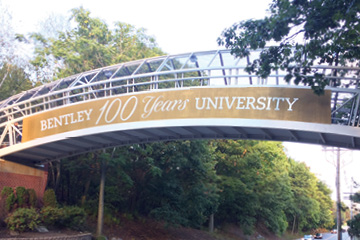 workhorse teaching facility from Bentley’s first year in Waltham. Again like the library, it needed to modernize obsolete systems and — more important — change layout, design and resources to meet the challenges of 21st-century business education. The building is set to reopen in January 2017.
workhorse teaching facility from Bentley’s first year in Waltham. Again like the library, it needed to modernize obsolete systems and — more important — change layout, design and resources to meet the challenges of 21st-century business education. The building is set to reopen in January 2017.
Another undertaking was improving the Student Center that had been constructed in 2002. The goal at that time was to address a source of competitive disadvantage for Bentley: space that fostered students’ sense of community. The addition completed in 2015 meets the goal at an even higher level, with office space for student organizations, new dining options and ample room to hang out.
“This project was focused on connection and collaboration,” said J. Andrew Shepardson, vice president for student affairs and dean of students. “It gives students a place to interact in a relaxed setting that is slightly removed from their busy and demanding lives.”
A project begun in fall 2016 is one of the most eagerly anticipated in decades: a multipurpose arena. Sited on the south campus, the arena will provide much-needed space for large events like Convoca - tion, concerts and lectures. It will also be the home rink for Bentley’s Division I hockey team. The projected opening is early 2018.
As President Larson observed, “We will continue to invest in important strategic initiatives that raise academic quality, as well as those that provide a rich student life, which all place-based higher education institutions should offer.”
IMPRESSIVE GAINS
From one man to 700 faculty and staff. Eighteen students to more than 5,600. A single room to 163 acres and 45 buildings (with one more coming soon).
Of all the ways to chart Bentley’s rise to international prominence over a century, this last measure — the development of campus — may top them all. One reason is the audacious nature of the move to Waltham. Another is the role of physical facilities in making education possible, and assuring competitiveness in a crowded higher education marketplace. Perhaps most important, the growth vividly illustrates an entrepreneurial spirit that defines this institution and the students, faculty, staff, trustees and alumni who call it their own.
Paul Carberry is director of foundation relations and served for many years as secretary of the college corporation.

